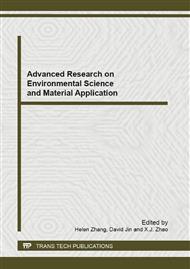[1]
Luft G, Bitsch H, Seidl H. Effectiveness of organic peroxide initiators in the high-pressure polymerization of ethylene, J of Macromole Scie. Part A: Pure and Applied Chemistry, vol. 11(6) (1997), p.1089.
DOI: 10.1080/00222337708061313
Google Scholar
[2]
Reimers JL, Schork FJ. Lauroyl peroxide as a cosurfactant in miniemulsion polymerization, Ind Eng Chem Res. Vol. 36(4) (1997), p.1085.
DOI: 10.1021/ie960217v
Google Scholar
[3]
Kossoy AA, Akhmetshin YG. Identification of kinetic models for the assessment of reaction hazards. Process Saf Prog. Vol. 26(3) (2007), p.209.
DOI: 10.1002/prs.10189
Google Scholar
[4]
Thermal Safety Software (TSS). ChemInform Saint Petersburg Ltd. (CISP), St. Petersburg, Russia, http: /www. cisp. spb. ru, (2012).
Google Scholar
[5]
Kosoy AA, Sheinman I. Comparative analysis of the methods for SADT determination, J Hazard Mater. Vo. 142 (2008) p.626.
Google Scholar
[6]
Lin YF, Tseng JM, Wu TC, Shu CM. Effects of acetone on methyl ethyl ketone peroxide runaway reaction, J Hazard Mater. Vol. 153(3) 2008, p.1071.
DOI: 10.1016/j.jhazmat.2007.09.099
Google Scholar
[7]
Wu SH, Wang YW, Wu TC, Hu WN, Shu CM. Evaluation of thermal hazards for dicumyl peroxide by DSC and VSP2. J Therm Anal Calorim. Vol. 93 (1) (2008), p.189.
DOI: 10.1007/s10973-007-8874-1
Google Scholar
[8]
Ozawa T. Modified method for kinetic analysis of thermoanalytical data. J Therm Anal Calorim. Vol. 9 (1976), p.369.
Google Scholar
[9]
Augis JA, Bennett JE. Calculation of the avrami parameters for heterogeneous solid-state reactions using a modification of the Kissinger method. J Therm Anal Calorim. Vol. 13 (1978), P. 283.
DOI: 10.1007/bf01912301
Google Scholar
[10]
Wu LK, Chen KY, Cheng SY, Lee BS, Shu CM. Thermal decomposition of hydrogen peroxide in the presence of sulfuric acid. J Therm Anal Calorim. Vol. 93(1) (2008), p.115.
DOI: 10.1007/s10973-007-8829-6
Google Scholar
[11]
Wei JM, You ML, Chu YC, Shu CM. Evaluation of thermal hazard for lauroyl peroxide by VSP2 and TAM III. J Therm Anal Calorim. 27 March (2012).
DOI: 10.1007/s10973-012-2350-2
Google Scholar
[12]
Fisher HG, Goetz DD. Determination of self-accelerating decomposition temperature using the accelerating rate calorimeter. J Loss Prev Process Ind. Vol. 4 (1991), p.305.
DOI: 10.1016/0950-4230(91)80044-u
Google Scholar
[13]
Barton J, Rogers R. Chemical Reaction Hazards – A Guide to Safety, 2nd ed., IChemE, UK, (1997), p.25.
Google Scholar
[14]
Lin CP, Chang CP, Chou YC, Chua YC, Shu CM. Modeling solid thermal explosion containment on reactor HNIW and HMX. J Hazard Mater. Vol. 176 (2010), p.549.
DOI: 10.1016/j.jhazmat.2009.11.064
Google Scholar


